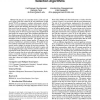Free Online Productivity Tools
i2Speak
i2Symbol
i2OCR
iTex2Img
iWeb2Print
iWeb2Shot
i2Type
iPdf2Split
iPdf2Merge
i2Bopomofo
i2Arabic
i2Style
i2Image
i2PDF
iLatex2Rtf
Sci2ools
IMC
2006
ACM
2006
ACM
The need for cross-layer information in access point selection algorithms
The low price of commodity wireless LAN cards and access points (APs) has resulted in the rich proliferation of high density WLANs in enterprise, academic environments, and public spaces. In such environments wireless clients have a variety of affiliation options that ultimately determine the quality of service they receive from the network. The state of the art mechanism behind such a decision typically relies on received signal strength, associating clients to that access point (AP) in their neighborhood that features the strongest signal. More intelligent algorithms have been further proposed in the literature. In this work we take a step back and look into the fundamental metrics that determine end user throughput in 802.11 wireless networks. We identify three such metrics pertaining to wireless channel quality, AP capacity in the presence of interference, and client contention. We modify the low level software functionality (firmware and microcode) of a commercial wireless adapt...
| Added | 13 Jun 2010 |
| Updated | 13 Jun 2010 |
| Type | Conference |
| Year | 2006 |
| Where | IMC |
| Authors | Karthikeyan Sundaresan, Konstantina Papagiannaki |
Comments (0)

